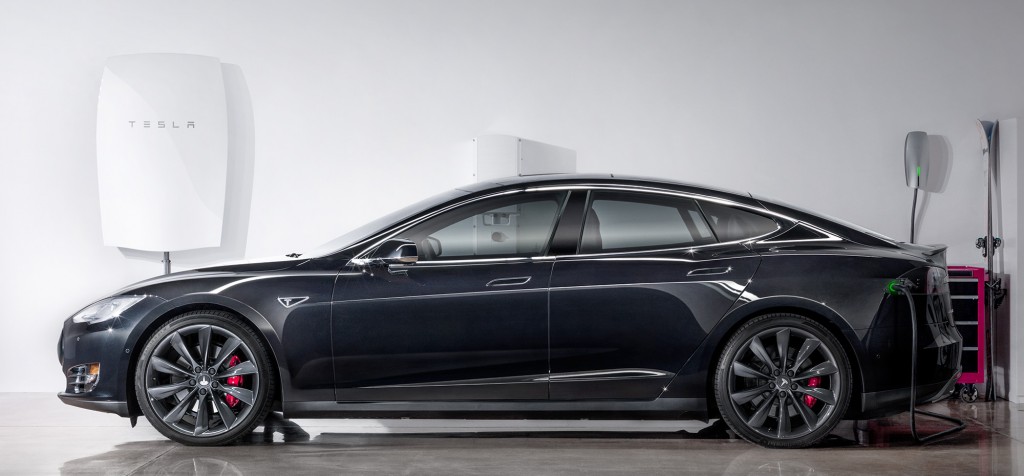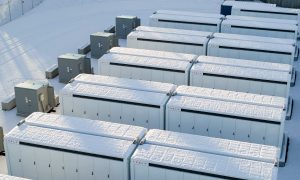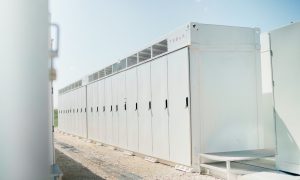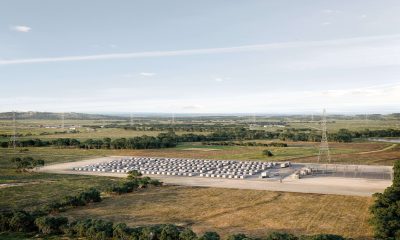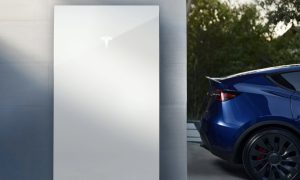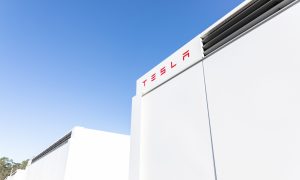Energy
Tesla PowerWall Debuts: $3,000 Home Battery
Tesla Energy has announced its new PowerWall residential storage battery. Price for a 7 kWh system is just $3,000. Several batteries can be interconnected.
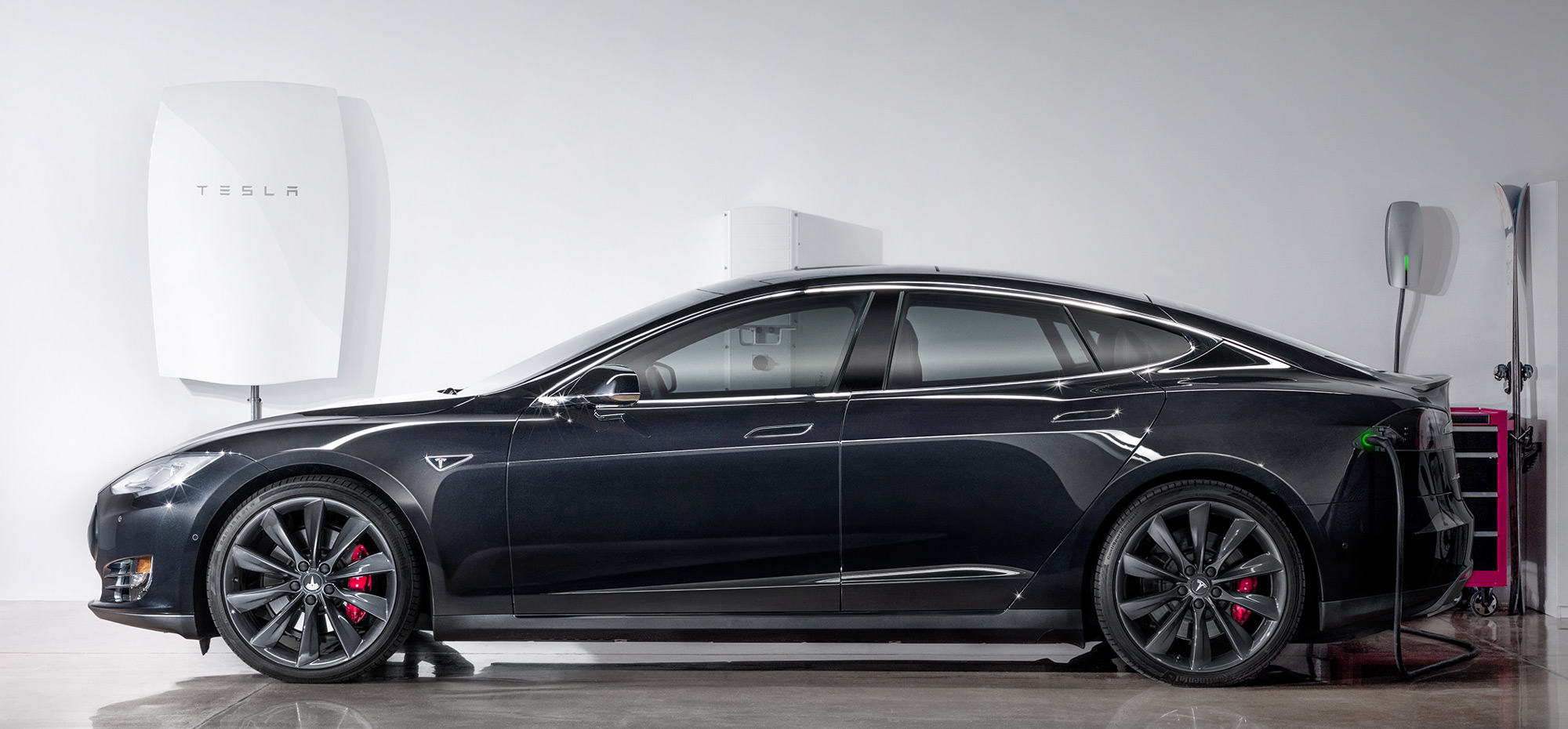
The world got its first look at the Tesla PowerWall yesterday during a splashy debut presentation – an event powered solely by energy collected from solar panels earlier in the day and stored in an array of PowerWall batteries. In essence, the PowerWall is a large uninterruptible power supply for homes. Elon Musk was in particularly high spirits as he modestly proclaimed this new technology could eliminate the world’s need for fossil fueled electricity forever.
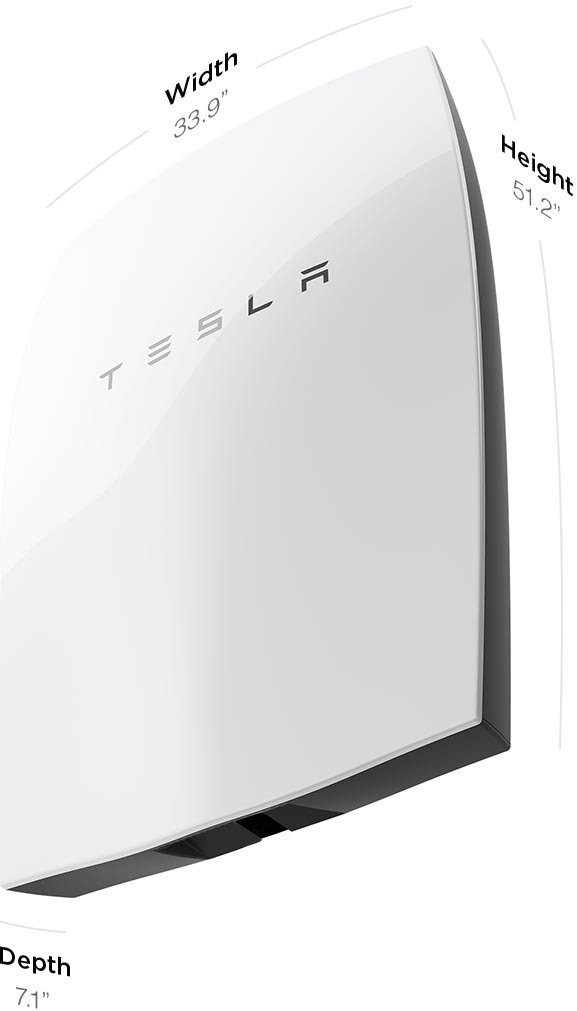
As technology journalist and Tesla owner Daniel Sparks correctly predicted on Tuesday, Tesla’s battery storage business will be conducted under the name Tesla Energy — a name the company reserved more than a decade ago. Tesla Energy will provide battery storage systems for three potential markets; residential, commercial and utilities.
Tesla PowerWall Residential System
The biggest news about the Tesla PowerWall battery storage system for residential customers is the price. A 7 kWh PowerWall is just $3,000. That’s far less than most observers expected. A 10 kWh system lists for $3,500. Do you need more than 10 kWh of storage? No problem. The units are designed so that as many as 9 of them can be plugged together for a total of 90 kWh of storage.
Here are the specs as provided by the Tesla Energy website:
- Technology Wall mounted, rechargeable lithium ion battery with liquid thermal control.
- Models 10 kWh $3,500 — for backup applications. 7 kWh $3,000 — for daily cycle applications
- Warranty Ten year warranty with an optional ten year extension.
- Efficiency 92% round-trip DC efficiency
- Power 2.0 kW continuous, 3.3 kW peak
- Voltage 350 – 450 volts
- Current 5 amp nominal, 8.5 amp peak output
- Compatibility Single phase and three phase utility grid compatible.
- Operating Temperature -4°F to 110°F / -20°C to 43°C
- Enclosure Rated for indoor and outdoor installation.
- Installation Requires installation by a trained electrician. AC-DC inverter not included.
- Weight 220 lbs / 100 kg
- Dimensions 52.1″ x 33.9″ x 7.1″ (130 cm x 86 cm x 18 cm)
- Certifications UL listed
Customers can sign up on the company website now to reserve a battery. Deliveries are expected to begin in late summer, with more capacity coming online as production at the Tesla GigaFactory begins in late 2016.
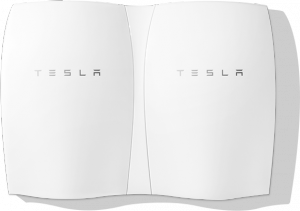 The PowerWall will be marketed to all homeowners, not just those with solar panels or other renewable energy systems. The concept is simple. The battery gets charged overnight when electricity rates are lowest. Then it is used to power the home during the morning and evening peak usage times, saving the customer enough money to more than pay for the system and installation.
The PowerWall will be marketed to all homeowners, not just those with solar panels or other renewable energy systems. The concept is simple. The battery gets charged overnight when electricity rates are lowest. Then it is used to power the home during the morning and evening peak usage times, saving the customer enough money to more than pay for the system and installation.
If the customer has a home solar system, it will charge the PowerWall during the day, reducing the need to buy any electricity from the grid even further. Depending on local conditions, customers can even sell any excess power back to the local utility company, reducing their electric bills that much more.
Tesla PowerPack For Commercial Customers
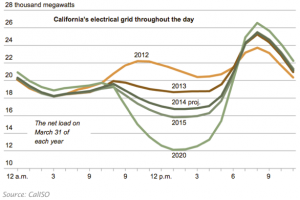 Tesla Energy has its sights on more than just residential customers. We know larger battery storage systems have been installed in 11 Walmart stores already. Now Amazon has committed to an enormous 4.8 mWh system for its western US data center, according to Gizmodo. Selected Target stores will also get Tesla Energy PowerPack systems.
Tesla Energy has its sights on more than just residential customers. We know larger battery storage systems have been installed in 11 Walmart stores already. Now Amazon has committed to an enormous 4.8 mWh system for its western US data center, according to Gizmodo. Selected Target stores will also get Tesla Energy PowerPack systems.
The benefits of on-site battery storage are magnified for large scale commercial operations. In the traditional business model used by utility companies. they have no choice but to buy power from the grid during peak demand times. Having on-site energy storage capability will allow then to charge their batteries when electricity costs the least and use that stored energy when it benefits them the most. Here’s more from the Tesla Energy website:
Based on the powertrain architecture and components of Tesla electric vehicles, Tesla energy storage systems deliver broad application compatibility and streamlined installation by integrating batteries, power electronics, thermal management and controls into a turn key system.
Tesla’s energy storage allows businesses to capture the full potential of their facility’s solar arrays by storing excess generation for later use and delivering solar power at all times. Business Storage anticipates and discharges stored power during a facility’s times of highest usage, reducing the demand charge component of the energy energy bills. Energy storage for business is designed to:
- Maximize consumption of on-site clean power
- Avoid peak demand charges
- Buy electricity when it’s cheapest
- Get paid by utility or intermediate service providers for participating in grid services
- Back up critical business operations in the event of a power outage
It’s a simple business case to make — our energy storage system will save your business tons of money. What business owner wouldn’t be happy with that?
Tesla Energy Grid Scale Storage
The most important part of Thursday’s announcement may turn out to be Tesla Energy’s entry into the grid scale energy storage market. Southern California Edison and OnCor have indicated interest in partnering with Tesla Energy on large scale energy storage installations. Elon Musk said Thursday night that phase of the business will be based on multiples of 100 kWh basic units that can interconnect to provide up to 10 megawatt-hours of electrical storage. Why is that important?
Since utility grids were first invented, the model has been for large generating plants located in or near major cities supplying electricity to the surrounding area. Eventually, long distance power transmission lines were constructed to connect those city scale power systems into regional power grids supplying millions of customers.
But renewable energy sources like wind or solar farms tend to focus on relatively small installations located far from urban centers. They feed their power into the grid from the edges, not from the middle. Roof top solar sytems for individual homes and small businesses feed small amounts of power into the grid from hundreds or even thousands of locations in the middle of the grid.
Utility grids are simply not constructed to behave efficiently with all that electricity being supplied from multiple sources. Home solar in particular has led to a dramatic increase in voltage fluctuations across entire grids. If those fluctuations are large enough, they can damage computers and other digital devices. Grid scale storage batteries can absorb all those spikes and fluctuations coming in and feed clean, well regulated electricity back out.
Generating plants and utility grids are expensive to build and maintain. Industry observers estimate utility companies in North America will need to spend as much as $ 1.5 trillion dollars by 2030 to build new electric generating facilities and maintain the utility grid. Some industry executives suggest that the best way to move forward is to dismantle the grid and transition to a microgrid model.
According to Green Tech Media, David Crane, CEO of NRG Energy, told an industry conference in February, 2014, “There will come a day, in a generation or so, when the grid is at best an antiquated system to a completely different way of buying electricity. Everyone just stop a moment and think how shockingly stupid it is to build a 21st-century electric system based on a system of 130 million wooden poles. Stop trying to rearrange the deck chairs on the Titanic, and start talking about, ‘How do we get rid of the grid?’”
Elon Musk will be more than happy to help Crane and his peers get rid of their grid. In his remarks, he told the audience that with 2 billion batteries and a lot of solar panels, the world could finally stop using fossil fuels to generate electricity altogether. He added that microgrids and renewable energy could empower large segments of the world’s population who presently have no access to electric power. Musk has always been a champion of ” disruptive technology.” It doesn’t get much more disruptive than dismantling the electrical grid and making electric utilities obsolete.
Demand curve chart via CaliSO
Energy
Tesla Lathrop Megafactory celebrates massive Megapack battery milestone
The Tesla Megapack is the backbone of Tesla Energy’s battery deployments.
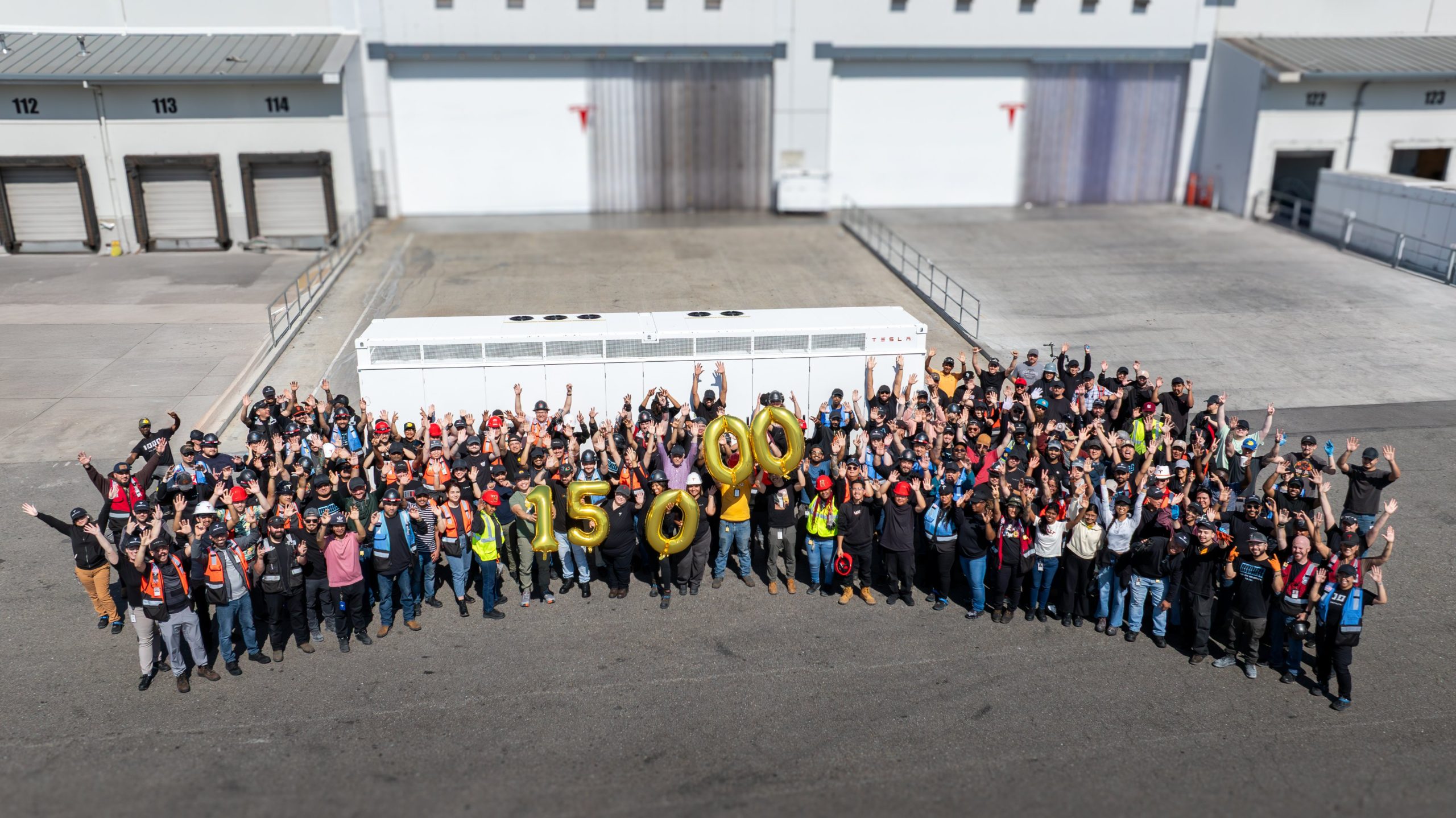
The Tesla Lathrop Megafactory recently achieved a new milestone. As per the official Tesla Megapack account on X, the Lathrop Megafactory has produced its 15,000th Megapack 2 XL battery.
15,000 Megapack Batteries
Tesla celebrated the milestone with a photo of the Lathrop Megafactory team posing with a freshly produced Megapack battery. To commemorate the event, the team held balloons that spelled out “15,000” as they posed for the photo.
The Tesla Megapack is the backbone of Tesla Energy’s battery deployments. Designed for grid-scale applications, each Megapack offers 3.9 MWh of energy and 1.9 MW of power. The battery is extremely scalable, making it perfect for massive energy storage projects.
More Megafactories
The Lathrop Megafactory is Tesla’s first dedicated facility for its flagship battery storage system. It currently stands as the largest utility-scale battery factory in North America. The facility is capable of producing 10,000 Megapack batteries every year, equal to 40 GWh of clean energy storage.
Thanks to the success of the Megapack, Tesla has expanded its energy business by building and launching the Shanghai Megafactory, which is also expected to produce 40 GWh of energy storage per year. The ramp of the Shanghai Megafactory is quite impressive, with Tesla noting in its Q1 2025 Update Letter that the Shanghai Megafactory managed to produce over 100 Megapack batteries in the first quarter alone.
Tesla Energy’s Potential
During the first quarter earnings call, CEO Elon Musk stated that the Megapack is extremely valuable to the energy industry.
“The Megapack enables utility companies to output far more total energy than would otherwise be the case… This is a massive unlock on total energy output of any given grid over the course of a year. And utility companies are beginning to realize this and are buying in our Megapacks at scale,” Musk said.
Energy
Tesla Megapacks powers the xAI Colossus supercomputer
Tesla Megapacks step in to stabilize xAI’s Colossus supercomputer, replacing natural gas turbines. Musk’s ventures keep intertwining.
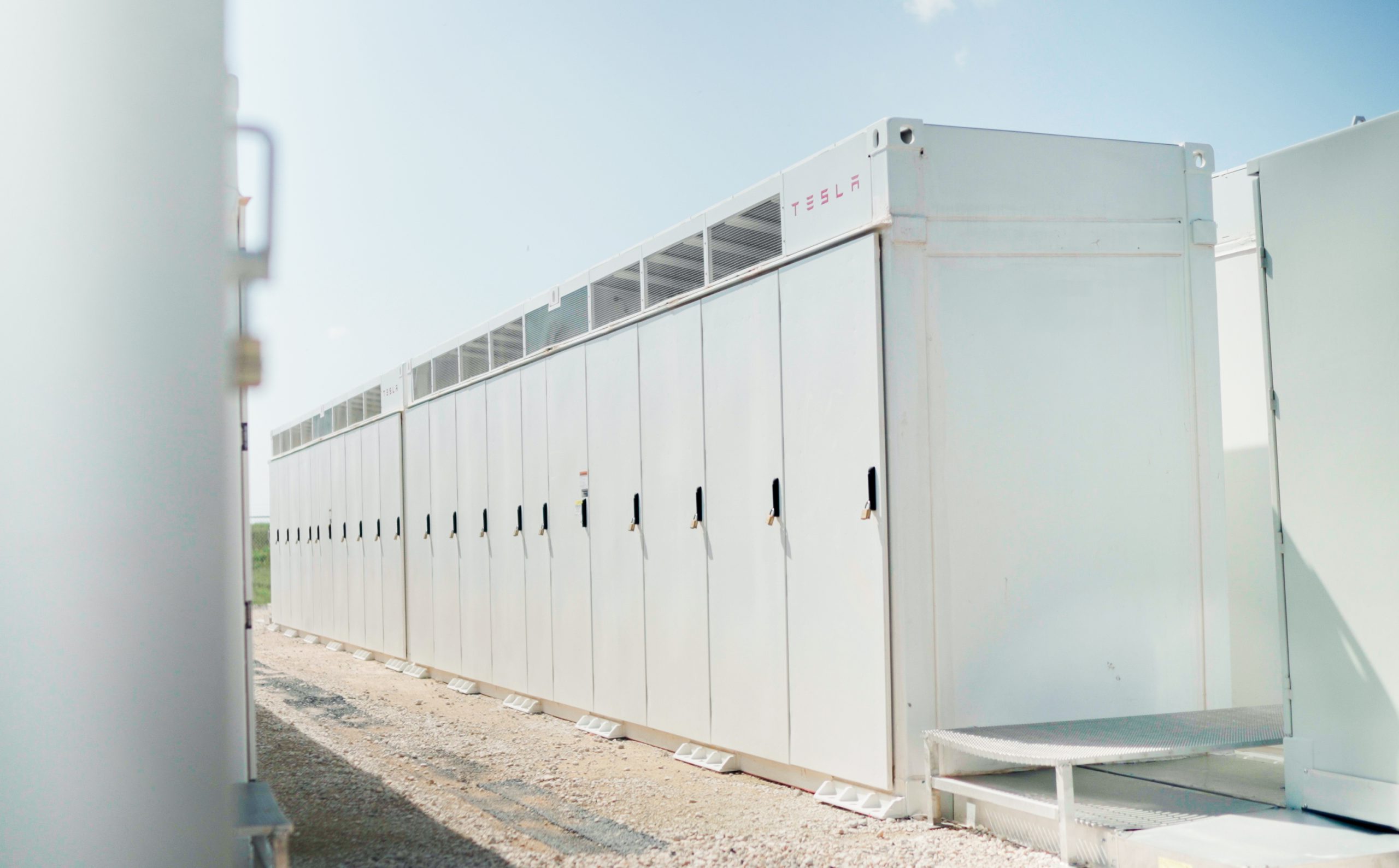
Tesla Megapack batteries will power the xAI Colossus supercomputer in Memphis to ensure power stability. The collaboration between Tesla and xAI highlights the synergy among Elon Musk’s ventures.
The artificial intelligence startup has integrated Tesla Megapacks to manage outages and demand surges, bolstering the facility’s reliability. The Greater Memphis Chamber announced that Colossus, recently connected to a new 150-megawatt electric substation, is completing its first construction phase. This transition addresses criticism from environmental justice groups over the initial use of natural gas turbines.
“The temporary natural gas turbines that were being used to power the Phase I GPUs prior to grid connection are now being demobilized and will be removed from the site over the next two months.
“About half of the operating turbines will remain operating to power Phase II GPUs of xAI until a second substation (#22) already in construction is completed and connected to the electric grid, which is planned for the Fall of 2025, at which time the remaining turbines will be relegated to a backup power role,” the Chamber stated.
xAI’s rapid development of Colossus reflects its ambition to advance AI capabilities, but the project has faced scrutiny for environmental impacts. The shift to Megapacks and grid power aims to mitigate these concerns while ensuring operational continuity.
The Megapack deployment underscores the collaboration among Musk’s companies, including Tesla, SpaceX, Neuralink, and The Boring Company. Tesla appears to be the common link between all of Musk’s companies. For example, The Boring Company built a tunnel in Giga, Texas. In addition, Musk has hinted at a potential collaboration between the Tesla Optimus Bot and Neuralink. And from January 2024 to February 2025, xAI invested $230 million in Megapacks, per a Tesla filing.
Tesla Energy reported a 156% year-over-year increase in Q1 2025, deploying 10.4 GWh of storage products, including Megapacks and Powerwalls. Tesla’s plans for a new Megapack factory in Waller County, Texas, which is expected to create 1,500 jobs in the area, further signal its commitment to scaling energy solutions.
As xAI leverages Tesla’s Megapacks to power Colossus, the integration showcases Musk’s interconnected business ecosystem. The supercomputer’s enhanced stability positions xAI to drive AI innovation, while Tesla’s energy solutions gain prominence, setting the stage for broader technological and economic impacts.
Energy
Tesla Energy celebrates one decade of sustainability
Tesla Energy has gone far since its early days, and it is now becoming a progressively bigger part of the company.
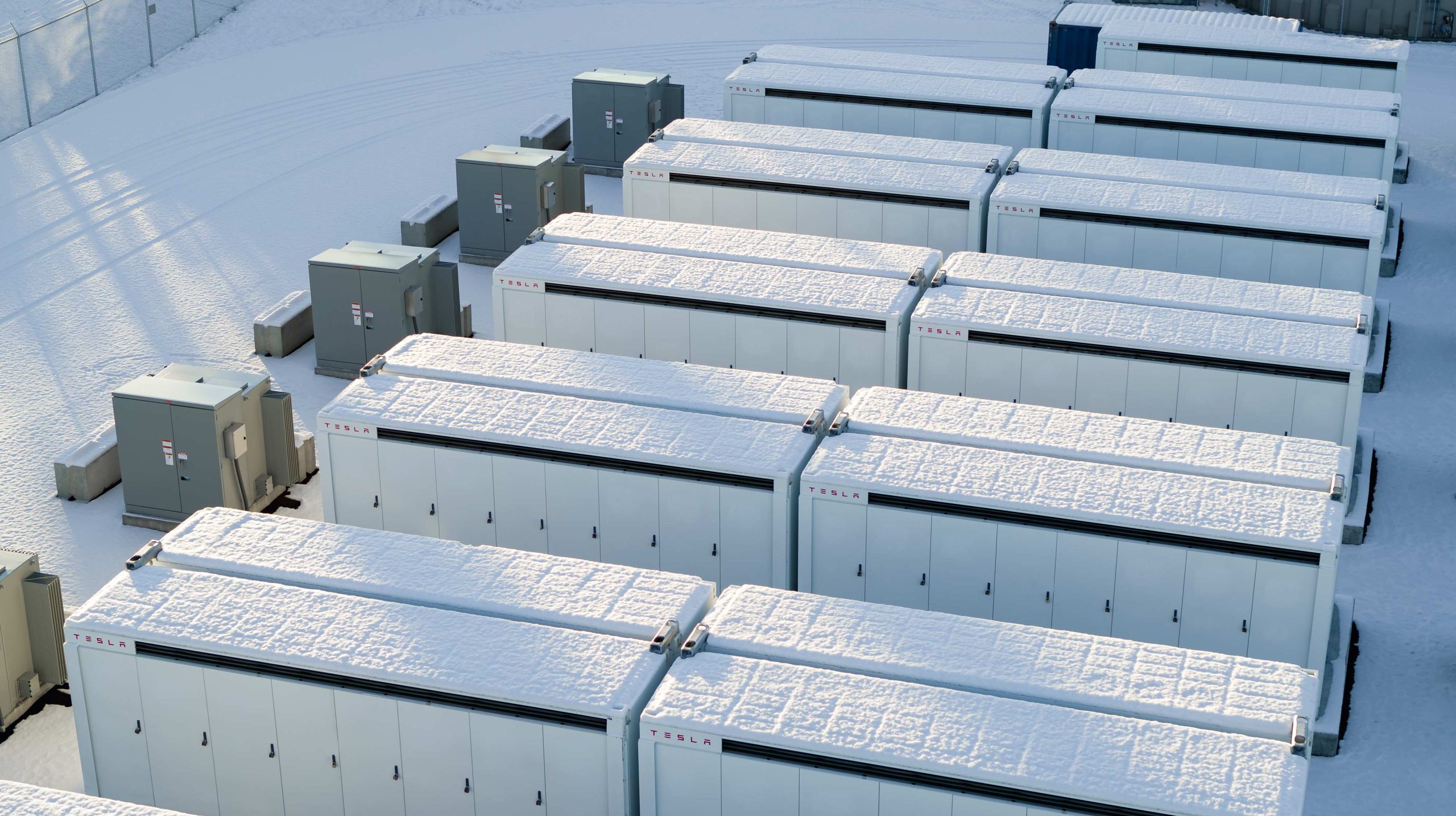
Tesla Energy recently celebrated its 10th anniversary with a dedicated video showcasing several of its milestones over the past decade.
Tesla Energy has gone far since its early days, and it is now becoming a progressively bigger part of the company.
Tesla Energy Early Days
When Elon Musk launched Tesla Energy in 2015, he noted that the business is a fundamental transformation of how the world works. To start, Tesla Energy offered the Powerwall, a 7 kWh/10 kWh home battery system, and the Powerpack, a grid-capable 100 kWh battery block that is designed for scalability. A few days after the products’ launch, Musk noted that Tesla had received 38,000 reservations for the Powerwall and 2,500 reservations for the Powerpack.
Tesla Energy’s beginnings would herald its quiet growth, with the company later announcing products like the Solar Roof tile, which is yet to be ramped, and the successor to the Powerwall, the 13.5 kWh Powerwall 2. In recent years, Tesla Energy also launched its Powerwall 3 home battery and the massive Megapack, a 3.9 MWh monster of a battery unit that has become the backbone for energy storage systems across the globe.
Key Milestones
As noted by Tesla Energy in its recent video, it has now established facilities that allow the company to manufacture 20,000 units of the Megapack every year, which should help grow the 23 GWh worth of Megapacks that have already been deployed globally.
The Powerwall remains a desirable home battery as well, with more than 850,000 units installed worldwide. These translate to 12 GWh of residential entry storage delivered to date. Just like the Megapack, Tesla is also ramping its production of the Powerwall, allowing the division to grow even more.
Tesla Energy’s Role
While Tesla Energy does not catch as much headlines as the company’s electric vehicle businesses, its contributions to the company’s bottom line have been growing. In the first quarter of 2025 alone, Tesla Energy deployed 10.4 GWh of energy storage products. Powerwall deployments also crossed 1 GWh in one quarter for the first time. As per Tesla in its Q1 2025 Update Letter, the gross margin for the Energy division has improved sequentially as well.
-

 Elon Musk2 weeks ago
Elon Musk2 weeks agoTesla investors will be shocked by Jim Cramer’s latest assessment
-

 Elon Musk2 days ago
Elon Musk2 days agoxAI launches Grok 4 with new $300/month SuperGrok Heavy subscription
-

 Elon Musk4 days ago
Elon Musk4 days agoElon Musk confirms Grok 4 launch on July 9 with livestream event
-

 News1 week ago
News1 week agoTesla Model 3 ranks as the safest new car in Europe for 2025, per Euro NCAP tests
-

 Elon Musk2 weeks ago
Elon Musk2 weeks agoA Tesla just delivered itself to a customer autonomously, Elon Musk confirms
-

 Elon Musk1 week ago
Elon Musk1 week agoxAI’s Memphis data center receives air permit despite community criticism
-

 News2 weeks ago
News2 weeks agoXiaomi CEO congratulates Tesla on first FSD delivery: “We have to continue learning!”
-

 News2 weeks ago
News2 weeks agoTesla sees explosive sales growth in UK, Spain, and Netherlands in June

